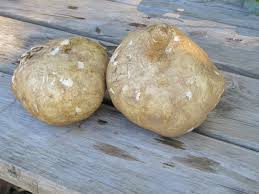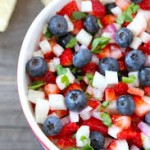Jicama (pronounced hee-cama) is a round, bulbous root vegetable with origins in the Mexican peninsula. It is part of the legume family. This little-known tuber is grown in the warm climates of Central America, the Caribbean, the Andes Mountain regions and Southern Asia, where it’s an important, as well as, extremely versatile food source.
It is very similar in texture to a turnip with a taste closer to an apple. It can be chopped, cubed, sliced into fine sticks, raw or cooked. Jicama is versatile and great in stir-fries, salads, slaw, soup, and with other veggies and fruits like oranges, apples, carrots, and onions, as well as, meats and seafood.
Low in calories but high in a few vital nutrients, jicama is a bit of a contradiction when it comes to its starch content. It provides one-quarter of what’s needed daily in fiber per serving. But not just any fiber – jicama’s fiber is infused with oligofructose inulin (big word but worthy of knowing), which has zero calories and doesn’t metabolize in the body. Inulin, a fructan, promotes bone health by enhancing absorption of calcium from other foods and protects against osteoporosis. Inulin also has a prebiotic role in the intestine – it promotes ‘good’ bacteria growth that maintains both a healthy colon and balanced immunity. Because it has a very low glycemic index, jicama is a great food for diabetics, and low in calories for those interested in weight reduction.
Jicama is also an excellent source of fiber and vitamin C – 44% of the daily value per serving – and a powerful antioxidant that zaps free radicals to protect against cancer, inflammation, viral cough, cold, and infections. Besides healthy amounts of potassium, this little powerhouse can help promote heart health since high-potassium vegetables and fruit are linked to lower risks of heart disease. Jicama contains important vitamins like folates, riboflavin, pyridoxine, pantothenic acid, and thiamin, and the minerals magnesium, copper, iron, and manganese.
So if you haven’t experienced jicama in your dining repertoire, you have everything to gain – and if you’re actually hoping to lose, this might be your new favorite.
If you are having a Memorial Day picnic, BBQ or family get-together, here are 3 of my favorite Red, White and Blue recipes:
1 cup fresh blueberries
1 cup diced strawberries
1 cup diced jicama
1/3 cup chopped cilantro
¼ cup finely chopped red onion
2 T. finely chopped jalapeno pepper, stemmed and seeded
Juice of 1 large lime
Salt to taste
Tortilla chips, for serving
1. In a medium bowl, combine blueberries, strawberries, jicama, cilantro, red onion, jalapeno, and lime juice. Stir until well combined.
2. Season with salt, to taste.
3. Serve with tortilla chips.
NOTE – this salsa is also great with grilled fish or chicken. It is best eaten the day it is made.
Yields 3 Cups
Compliments of Two Peas and Their Pod
Red White and Blue Fruit Salad
2 cups watermelon, cubed
1 cup jicama, peeled and cubed
1 cup blueberries
2 T. lime juice
2 T. honey
pinch of chili powder
½ tsp. salt
¼ cup fresh mint, chopped
¼ cup feta cheese, crumbled
1. Mix watermelon, jicama and blueberries in a large bowl.
2. Mix the lime juice, honey, chili powder and salt in a small bowl and pour over the watermelon mixture.
3. Add mint and more salt to taste and top with feta cheese crumbles.
4. Chill for 30-60 minutes before serving.
Serves 6
Compliments of Foodie Crush
Red White and Blue Frozen Bark
3 cups yogurt
½ cup honey
1 cup white chocolate chips
1 cup fresh raspberries
1 cup fresh blueberries
1. In a medium bowl, combine the yogurt and honey until well combined.
2. Using a spatula, fold in the white chocolate chips.
3. Line a cookie sheet with foil or parchment paper. Pour the yogurt mixture evenly over the cookie sheet, smoothing with your spatula. Evenly distribute the raspberries and blueberries over the top of the yogurt mixture.
4. Put in the freezer and chill for at least 2 hours. Break into large pieces to serve. Serve cold and keep in freezer or on ice.
Compliments of Honey and Birch


